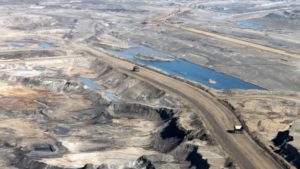On 10 May Alberta’s Court of Appeal provided an opinion on reference questions from the Alberta government concerning the validity of the federal Impact Assessment Act or, as Premier Kenney prefers to call it, the “no pipelines law.”
Background .
On 9 September 2019 Alberta’s cabinet authorized the Alberta Court of Appeal to consider two questions. These were:
- Is Part 1 of An Act to enact the Impact Assessment Act and the Canadian Energy Regulator Act, to amend the Navigation Protection Act and to make consequential amendments to other Acts, S.C. 2019, c. 28, unconstitutional in whole or in part, as being beyond the legislative authority of the Parliament of Canada under the Constitution of Canada?
- Is the Physical Activities Regulations, SOR/2019-285, unconstitutional in whole or in part by virtue of purporting to apply to certain activities listed in Schedule 2 thereof that relate to matters entirely within the legislative authority of the Provinces under the Constitution
of Canada?
Oral arguments were made to the court in a special hearing between 22-25 February 2021. The majority was lead by Chief Justice Catherine Fraser, Justice Jack Watson and Justice Bruce McDonald. The opinion was concurred in by Justice Joanne Strekaf except for paragraphs 374 to 377 (discussed below).
Intervenors included the Attorney Generals of Ontario and Saskatchewan, the Canadian Environmental Law Association, Environmental Defence, Canada Inc., Miningwatch Canada Inc., Nature Canada, Woodland Cree First Nation, Canadian Association of Petroleum Producers, the Explorers and Producers Association of Canada, Canadian Energy Pipeline Association, Indian Resource Council, Mikisew Cree First Nation, Ecojustice Canada Society, Canadian Taxpayers Federation, Independent Contractors and Businesses Association, the Alberta Enterprise Group, and the Athabasca Chipewyan First Nation.

In a 4-1 decision, Justice Greckol dissenting, the Alberta Court of Appeal held that the Impact Assessment Act to be ultra vires the Parliament of Canada or unconstitutional. The Court described the law as a dramatic overreach, a hardly veiled attempt to choke Alberta’s and all provinces’ capacities to develop their natural resources. The language in this Reference opinion was very strong. The decision is enormously significant as it gives the province and its Army of Wexiters a confirming legal decision which aims to correct an apparent imbalance in the current state of Canadian federalism.
The central thesis of the opinion is that the 1982 Constitution Act, specifically section 92A and the amending formula, solidified provinces’ exclusive jurisdiction over natural resources (paras 74-83).
To the extent ambiguity existed with respect to a province’s exclusive right to exploit the 92A natural resources it owned, s 92A put this beyond doubt. No principled reason exists to diminish the full import of the exclusive jurisdiction conferred on the provinces under s 92A(1).
Para. 80.
The majority argues the division of powers gives the province the exclusive right to develop its natural resources especially intra-provincial projects (“local works and undertakings”). Undertaking is actually a good word given that unfettered fossil-fuel development will lead to a global undertaking.
Notably the majority acknowledges that section 92A does not override Parliament’s “Peace, Order and good government power.
The Court described the provenance of the amendment as part of a “grand bargain” or in the Court’s opinion a “negotiated compromise.” In that grand bargain was the equalization principle which the Court uses as a bit of a cudgel against federal overreach. The Court is effectively reminding the federal government that Alberta has honored its part of the grand bargain by supplying hundreds of billions to other provinces mainly through its exploitation of Alberta’s natural resources.
Since patriation, Alberta has contributed to the federal government hundreds of billions of dollars more than it has received. These funds have in turn assisted the federal government in its financial capacity to make equalization payments to other provinces. Alberta’s agreement to s 36, including the concept of equalization payments, was based not only on the inclusion of the Resource Amendment and the s 38 opt-out right but also on the federal government’s commitment to further economic development
(Para. 71- emphasis added).
(Trevor Tombe from the University of Calgary is quoted as the authority for the transfers and Meekison, Romanow, and Leeson are authorities on the 1982 patriation deal (paras. 64-73)), It seems unusual for the Court to bring up a hot button issue like equalization in the context of the grand bargain. The context set includes a brief historical review of the 1930 resource agreement also a hot button with western separatists. Alberta and Saskatchewan were not given control over their natural resources until 25 years after their creation. Manitoba also was given control a full 60-years after its entry into Confederation. This piece of context points to an acute sensitivity of most western politicians, and now one of its appellate courts to the treatment of western provinces as colonies of central Canada- which was very much the case.
Next the majority examines the evolution of federal environmental legislation. This part of the judgment is significant because the majority’s version is challenged in the dissenting opinion of Justice Greckol. The majority shows, or purports to show, the progressive creep of Liberal governments in the 90s, the “scale back” under Harper’s Tories (“Canada as an energy superpower”) in 2012 amendments and the most recent federal (Liberal) incursion of C- 69 in 2018 (paras. 84-99).
The Canadian Environmental Assessment Act, 1992 was passed in the dying days of the Mulroney government. The Act featured four levels of assessment depending on the nature of the project. In 2012 came a Harper government enactment to amend this Act called Jobs and Economic Growth Act whose title suggests it was an industry friendly piece of legislation. It addressed a number of provincial government concerns. In particular it gave the federal government the ability to delegate to provinces the assessment if “equivalency” conditions were met. Importantly it created deadlines for different points in the process which was changed under Bill c-69 (para. 350). In addition, the 2013 legislation gave to the Minister of the Environment the ability to designate which projects would be subject to review and those that were not (para. 95). The amendments also limited who could be “affected parties’ under the Act and who could appear before the tribunals (para. 99). According to the majority, the changes “
In their opinion, the 2018 legislation authorized federal government’s incursion into provincial decision-

making and “allows the federal government to pick winners and losers, not just in terms of individual intra-provincial designated projects, and individual categories thereof, but also in terms of individual provinces” (para. 26). Not picking winners and losers was, of course, one of Ralph Klein’s famous sayings and its use in a reference case has political overtones.
The majority argues that traditional court deference to cooperative federalism should not override federal and provincial heads of power (paras. 186-189). This approach, which seems eminently reasonable is similar to the originalist thinking of the US Supreme Court. It contrasts with the notion of the Constitution as a ‘living tree.’ The Alberta Court of Appeal was critical of the notion of judge made law, preferring to see legislators sorting out issues such as environmental laws. There was obvious merit in this concern. We may expect some rebuttals of this judicial approach when the Supreme Court rules, probably next year, on the federal government’s appeal.
All justices recognized the existential crisis that is climate change (para. 6). However, the majority held that this overarching concern does not trump, and should not trump, the division of powers within the Constitution.
In various quarters the majority’s decision was viewed as overly political. And for good reason, For example:
To bring this down to reality, there are several ways GHG emissions could be reduced. A few examples, which admittedly are at one end of the extreme, for illustrative purposes only. Limit the number of children per family Stop eating beef and become vegetarian. Stop drinking dairy milk. Stop living in single family homes. Limit the square footage a person, couple or family can occupy. Stop heating homes above a prescribed temperature and stop cooling homes below a prescribed temperature. Stop using gas appliances. Stop driving vehicles that cannot achieve a stringent mileage level per litre. Stop driving vehicles of any kind. Stop taking holidays that involve leaving home by plane, car or bus. Stop eating as much. Stop spending as much on consumer goods. Shut down all cruise vessels and all plane travel for pleasure. Shut down the dairy and cattle industry. Shut down all cement plants. Shut down the auto industry and aerospace industry. Shut down all electrical power generation plants. Shut down the production and export of coal. And shut down the entire Canadian oil and gas industry.
(Para 294)
This avowedly political perspective has no place in a judicial opinion of this import. It ridicules persons who have identified a range of sources of GHGs, including the vegan movement, as naïve, impractical idealists who want to shut down the modern industrial economy. Most environmentalists I know of accept the necessity of transitioning to a green future. No one says it will be easy but shots at tree huggers are disrespectful and will do nothing to illicit support for controls on federal environmental assessments. The fact of the matter is that respected organizations such as the International Energy Agency have called for a halt on the development of new oil and gas fields (p. 20). This paragraph diminishes respect in this appellate court- a court that has a reputation for having its majority decisions overturned.
The case law is quite clear that the environment is shared jurisdiction (“abstruse” in the words of former Supreme Court Justice Gerald La Forest). While the majority accepts the greenhouse gas emissions judgment of the Supreme Court, the ACA rejects federal intrusion into intra-provincial works and undertakings (section 92 (10) of the Constitution Act) and how the federal legislation purports to regulate these projects, It will be very interesting to see whether the Supreme Court attempts to place limits on the exercise of the sweeping power of the IIA.
The dissent
 Writing legal opinions is like the ancient art of rhetoric. You provide your context, marshal your arguments, perhaps avoid inconvenient facts, and emphasize precedents which are often used by both sides given the inherent ambiguity.
Writing legal opinions is like the ancient art of rhetoric. You provide your context, marshal your arguments, perhaps avoid inconvenient facts, and emphasize precedents which are often used by both sides given the inherent ambiguity.
The Greckol dissent in Re. Impact Assessment Act is a case in point. All justices and their clerks know the prominent division of powers’ cases inside and out. Each Justice attempts to create novel interpretations of the Constitution Acts 1867 to present. In Greckol’s opinion she adopts various metaphors found in constitutional cases-notably the ‘living tree’ view of constitutional interpretation. This approach allows courts more latitude to assess division of powers in a more progressive way.
A democratically elected Parliament is free to design an environmental protection approach of its choice, so long as it acts within constitutional constraints. Indeed, it would be surprising if it did not change that approach to meet the challenges of the ever-increasing threat posed by environmental degradation and the climate crisis. Some might call this progress. In any event, Canada’s choice of approach to environmental issues is an expression of the will of the people; Canadians are often in the vanguard of progress on the fundamental social issues of our times.
(Para. 445, emphasis added).
Her summary of various federal laws governing the environment sheds a very different light on the impact Assessment Act than that of the majority which saw a progressively intrusive federal overreach. Justice Greckol’s view is that the CIAA was an incremental evolution of environmental policy that has been upheld by the courts. Indeed, the industry-friendly changes to the legislation in 2012 – Harper held a majority government at the time- put in place some of the structures which the IAA built upon, notably the project-based assessment.
In her comparison between the harper era CEAA and the Trudeau area, she notes that threshold levels for pipelines were raised, not lowered as well as production capacity of projects like coal mining. Indeed many of the thresholds were not changed including Mine projects and oil refineries (paras. 518-519). Some projects were eliminated including decommissioning and abandoning of existing pipelines. Notably, “(N)o proponents of projects affected by this legislation have challenged its
constitutionality or other aspects of its application (para. 523). Indeed, “since the
trigger post-2012 is limited to a handful of matters (e.g., fish, migratory birds, but excluding pre-
2012 matters like navigable waters), the number of projects undergoing federal assessment has
been reduced from around 3000 per year to around 70 per year” (para. 678) which suggests federal overreach should be taken with a grain of salt.
Justice Greckol also makes clear that the real reason for the reference case is that in situ oilsands extraction had been included as a class of designated projects. She cites the Affidavit of Paul Tsounis from Alberta’s Energy Department who stated that 81% of future oil sands extraction will use in situ methods generally perceived as less destructive that open pit mining. Hence the reference case.
Since the province and industry wish to expand the production of the resource (Kenney was down in Washington on 17 May trying to convince senators about the wisdom of buying more Canadian oil) federal oversight – or a de facto veto in the Court’s words- the future is less certain. Future uncertainty, the majority argues is it killer for investment and jobs. This is the crux of the issue. The IAA effectively gives the federal Executive-read federal Liberals/NDP alliance- a say on oilsands expansion which, of course, the UCP government and possibly the NDP opposition. do not want.
Despite all the arguments that economic growth can be reconciled with the environment, the plain truth is that further expansion of fossil fuel production is killing the planet at an accelerating rate. Both sides accept that climate change is an existential challenge but the majority believe that there is more to life than a safe environment apparently.
Paragraphs 374 to 377
Justice Strekaf did not concur with paragraphs 374-377 of the majority opinion. This section is entitled “De Facto Expropriation.” Using particularly strong language, the majority held that
Were this legislative scheme upheld, it would arguably raise other issues relating to de facto expropriation as well. That would include whether this scheme effectively strips the provinces of their proprietary and development rights in their own property, including their natural resources. That would raise in turn whether, and at what point, this constitutes a de facto
expropriation of such property:Para. 375 – emphasis added
The majority holds that the federal government has the power to expropriate property but it must do so under a valid head of federal power. The practical effect of the legislation according to the majority is that it sterilizes development in an provincial area of proprietary rights- public lands and natural resources. The majority is thus making the argument that even if the federal law is upheld by the Supreme Court, there may be a significant cause of action by provincial governments to seek compensation for the “de facto” sterilization of its natural resources. Justice Strekaf did not support this interesting perspective.
Will this assets become stranded? And who will pay?

There is an intriguing parallel between Social Credit assaults against the federal banking system rebuffed both by the power of reservation, federal cabinet’s disallowance power, and court decisions. Energy development has been viewed as provincial jurisdiction in this province and it will be tough for industry to adjust to federal oversight through the environmental assessment process.
Recently, in the Redwater decision the Supreme Court overturned a Alberta Court of Appeal decision which had held federal insolvency and bankruptcy powers trumped provincial polluter pay regulation. In that case the dissent, Justice Shelagh Martin was supported by the Supreme Court who sided with provincial authority to clean up the environment. Whether Justice Greckol’s arguments will win the day remains to be seen.
This case now appealed to the Supreme Court will confront a nation which is increasingly divided between fossil fuel supporters and gasoline-dependent consumers. Should the Supreme Court rule, likely after the May 2023 Alberta general election in favour of the federal government, all hell will break loose. Judicial lawmaking by a Liberal controlled court, etc. will be the chant. Indeed, to Alberto Wexiters, the federal Executive’s decision last month to allow development of an offshore oil development off Newfoundland is ample proof that Ottawa intends to play favourites.
The bottom line? The emerging reality of climate change which becomes clearer every week is unless draconian measures are taken by national governments stopping the expansion of fossil fuel production, our species are doomed to escalating climate violence.
Related Posts